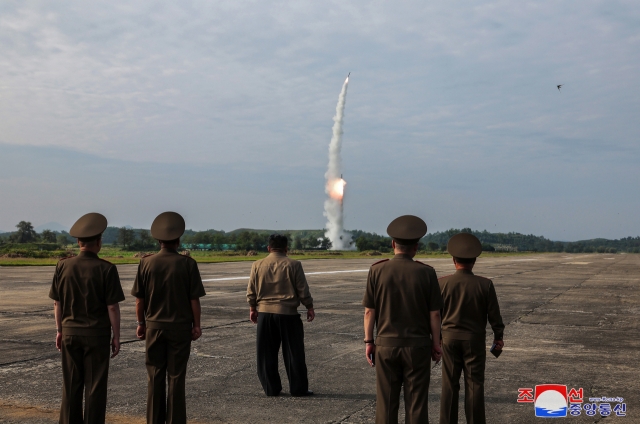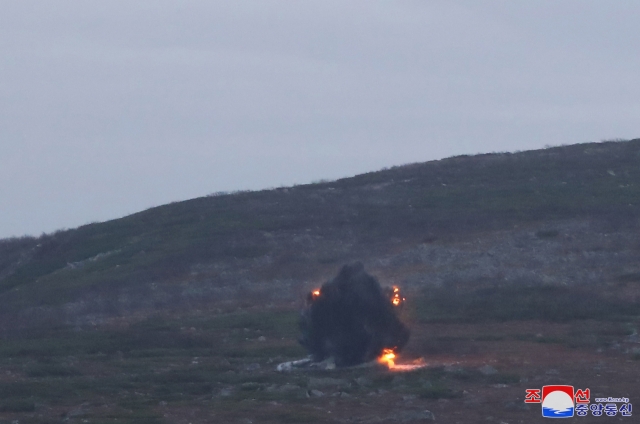NK media 'unusally' silent over Kim Jong-un's new missile tests: Seoul
By Ji Da-gyumPublished : Sept. 19, 2024 - 15:18

While North Korea’s state-run Korea Central News Agency ran coverage of test-launches of new ballistic and crucise missiles on Thursday, the country’s domestically focused newspaper remained unusually quiet on the launches.
North Korean leader Kim Jong-un supervised the tests of tactical ballistic missiles fitted with "super-large" warheads and modified cruise missiles on Wednesday, according to the KCNA, which is focused largely on an international audience.
But the Rodong Sinmun, North Korea’s most widely circulated newspaper, remained silent on the event, a move the Unification Ministry in Seoul called "unusual" given the regime's typical coordination of domestic and international reports on its leader's public activities.
According to the KCNA report, North Korea's Missile Administration had "successfully" conducted test-fires of the Hwasongpho-11-Da-4.5 as well as a "strategic cruise missile whose performance has been highly upgraded for its combat use."
The ballistic missile was armed with a "4.5-ton super-large conventional warhead," the KCNA said, with the test designed to verify the missile's "accuracy of hit at medium range of 320 km and explosive power of the super-large warhead with a missile loaded with such a warhead."
The Unification Ministry is currently examining several potential reasons for the absence of Kim’s military activities from the Rodong Sinmun, North Korea’s primary domestic news source, and whether similar precedents exist.
Last week, the Rodong Sinmun and other state media outlets extensively covered six military-related activities by Kim Jong-un from Sept. 8-13, including supervising the test-firing of a new 600mm multiple rocket launcher and inspection of a uranium enrichment facility producing weapons-grade nuclear material.
Jung Dae-jin, a professor at Halla University in Wonju, Gangwon Province, suggested that "North Korea may have deemed last week's military reports sufficient for domestic consolidation."
"Kim Jong-un’s emphasis on self-defense military capabilities, demonstrated during his supervision of the missile test with a 4.5-ton super-large warhead and his other field inspections, appeared to be primarily targeted at government officials and external audiences, which makes the selective media coverage understandable," Jung said.
Kim said Wednesday that the missile "tests and steady improvement of performance of weapons and equipment through them are directly related to the grave threat of outside forces to the state security environment" of North Korea, according to KCNA.
However, Jung also noted, "If necessary, the missile test could still appear in Rodong Sinmun tomorrow. Such decisions are often made based on internal judgment."

The report by the KCNA, meanwhile, was the first time North Korea has explicitly declared that it deliberately launched a missile toward an inland target, rather than over water -- an action widely interpreted as a show of confidence.
Hong Min, a senior research fellow at the government-funded Korea Institute for National Unification, noted that while the first test launch of the Hwasongpho-11-Da-4.5 on July 1 "focused on verifying flight stability and hit accuracy, the latest test aimed to confirm both target hit precision and the explosive power of the super-large warhead."
Hong pointed out that the photographs released by KCNA intentionally showcased the missile striking the center of a crosshair target from a vertical angle, underscoring its precision and subtly depicting the missile’s warhead penetrating the ground.
"This demonstrates North Korea's ability to strike bunkered underground facilities through ground penetration," Hong said.
Hong further pointed out that the distance from Kaechon, in South Pyongan Province, to Camp Humphreys in Pyeongtaek, along South Korea’s western coast, falls precisely within the 320 km range tested.
"While framed as an experimental launch, the selection of Kaechon as the launch site appears deliberate, likely aimed at demonstrating North Korea’s ability to target US military bases at medium range," Hong said.
Hong assessed that the simultaneous testing of ballistic and cruise missiles was intended to "demonstrate North Korea’s capability to target US military bases and strike naval forces approaching by sea," aligning with the country's anti-access/area-denial (A2/AD) strategy.
"With the US presidential election approaching, the unveiling of these new weapons systems appears to be a calculated move to emphasize North Korea’s minimum deterrence capability against the US," Hong explained.
While overseeing the tests, Kim stated, "only when we have strong power, can we contain and frustrate the enemies' strategic misjudgment and will to use armed forces," adding that "this is a true deterrent for defending peace and stability," according to KCNA.









![[Off the Pages] German bestseller gets new twist in ‘Snow White Must Die -- Black Out’](http://res.heraldm.com/phpwas/restmb_idxmake.php?idx=644&simg=/content/image/2024/09/18/20240918050135_0.jpg&u=20240918224252)









